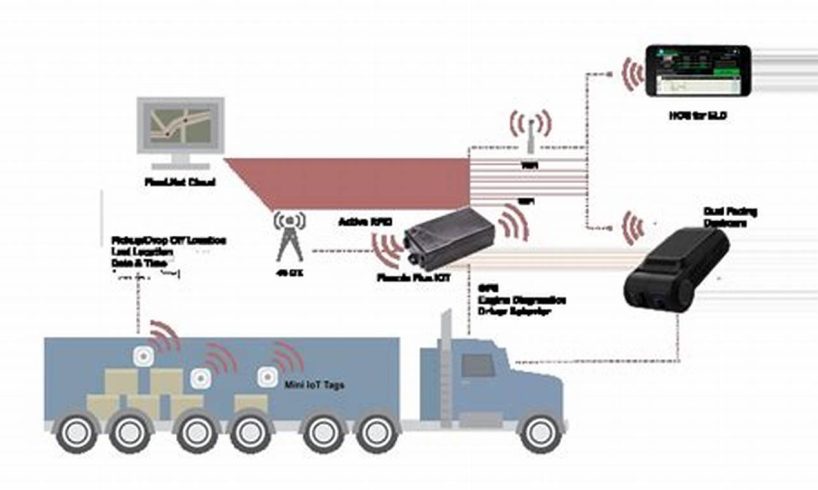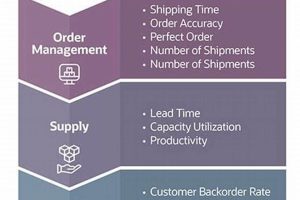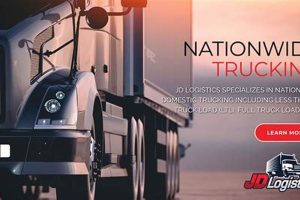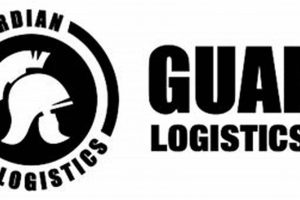
Logistics tracking devices are electronic devices that are used to track the movement of goods and assets. They can be attached to shipments, vehicles, containers, or other objects, and they use GPS, cellular, or satellite technology to transmit their location data to a central tracking platform.
Logistics tracking devices are becoming increasingly important in the supply chain industry, as they can provide real-time visibility into the movement of goods. This information can be used to improve efficiency, reduce costs, and enhance customer service.
1. Real-time visibility
Real-time visibility is a critical component of logistics tracking devices. It refers to the ability to track the location and status of shipments in real time. This information is essential for businesses to manage their supply chains effectively, as it allows them to:
- Identify and resolve delays
- Optimize delivery routes
- Reduce inventory levels
- Improve customer service
For example, a logistics company can use real-time visibility to track the location of a shipment of perishable goods. If the shipment is delayed, the company can take immediate action to reroute it or arrange for a replacement shipment. This helps to ensure that the goods are delivered to the customer on time and in good condition.
Real-time visibility is also essential for businesses that need to comply with regulatory requirements. For example, the pharmaceutical industry is required to track the temperature of shipments of vaccines and other temperature-sensitive products. Logistics tracking devices with real-time visibility can help businesses to ensure that these products are stored and transported at the correct temperature.
2. Improved efficiency
Improved efficiency is a key benefit of logistics tracking devices. These devices can help businesses to improve efficiency in a number of ways, including:
- Reducing paperwork and manual processes
- Automating tasks
- Improving communication and collaboration
- Optimizing inventory levels
- Reducing waste
- Improving delivery routes
For example, a logistics company can use logistics tracking devices to automate the process of tracking the location of shipments. This can free up employees to focus on other tasks, such as customer service or sales. Logistics tracking devices can also be used to optimize inventory levels by providing real-time data on the location and status of inventory. This information can help businesses to avoid stockouts and overstocking.
Improved efficiency can lead to significant cost savings for businesses. For example, a study by the Aberdeen Group found that companies that use logistics tracking devices can reduce their transportation costs by up to 10%. Improved efficiency can also lead to improved customer service, as businesses are able to respond to customer inquiries more quickly and accurately.
3. Reduced costs
Reduced costs are a key benefit of logistics tracking devices. These devices can help businesses to reduce costs in a number of ways, including:
- Reducing fuel consumption
- Optimizing inventory levels
- Reducing labor costs
- Improving delivery routes
- Reducing waste
For example, a logistics company can use logistics tracking devices to optimize delivery routes. This can help to reduce fuel consumption and labor costs. Logistics tracking devices can also be used to reduce inventory levels by providing real-time data on the location and status of inventory. This can help businesses to avoid stockouts and overstocking, which can lead to reduced waste.
Reduced costs can lead to significant savings for businesses. For example, a study by the Aberdeen Group found that companies that use logistics tracking devices can reduce their transportation costs by up to 10%. Reduced costs can also lead to improved profitability and competitiveness.
4. Enhanced customer service
Logistics tracking devices can help businesses to enhance customer service in a number of ways, including:
- Providing real-time visibility into the location and status of shipments
- Enabling businesses to proactively communicate with customers about delays or other issues
- Resolving customer inquiries more quickly and accurately
For example, a logistics company can use logistics tracking devices to provide real-time visibility into the location of a customer’s shipment. This information can be shared with the customer via a tracking portal or mobile app. The customer can then track the progress of their shipment and receive updates on its estimated delivery time. This helps to keep customers informed and reduces the need for them to contact the logistics company for updates.
Logistics tracking devices can also help businesses to proactively communicate with customers about delays or other issues. For example, if a shipment is delayed due to weather or traffic, the logistics company can use logistics tracking devices to identify the delay and proactively notify the customer. This allows the customer to make alternative arrangements, such as rescheduling the delivery or picking up the shipment from a different location.
Finally, logistics tracking devices can help businesses to resolve customer inquiries more quickly and accurately. For example, if a customer calls to inquire about the status of their shipment, the logistics company can use logistics tracking devices to quickly and accurately locate the shipment and provide the customer with the latest information. This helps to improve customer satisfaction and reduce the need for customers to call back with additional inquiries.
In summary, logistics tracking devices can help businesses to enhance customer service by providing real-time visibility into the location and status of shipments, enabling businesses to proactively communicate with customers about delays or other issues, and resolving customer inquiries more quickly and accurately.
5. Theft prevention
Theft prevention is a critical component of logistics tracking devices, as it enables businesses to protect their valuable assets from theft and unauthorized access. Logistics tracking devices can be equipped with a variety of features that deter theft, such as:
- GPS tracking: This allows businesses to track the location of their assets in real time, so they can be quickly recovered if stolen.
- Geofencing: This allows businesses to set up virtual boundaries around their assets, so they can be alerted if the asset leaves the boundary without authorization.
- Sensors: These can be used to detect if an asset has been tampered with or moved without authorization.
- Immobilization: This allows businesses to remotely immobilize their assets if they are stolen, making them more difficult to transport and sell.
These features make logistics tracking devices an effective tool for theft prevention, as they provide businesses with the ability to track, monitor, and protect their valuable assets. In addition, logistics tracking devices can help businesses to reduce their insurance premiums, as insurance companies view businesses that use these devices as being less risky.
For example, a logistics company can use logistics tracking devices to track the location of its fleet of trucks. If a truck is stolen, the company can use the GPS tracking feature to track its location and recover it quickly. This can help to reduce the company’s losses and protect its valuable assets.
6. Data analytics
Data analytics plays a crucial role in enhancing the capabilities of logistics tracking devices. By leveraging the data generated by these devices, businesses can gain valuable insights into their supply chain operations, leading to improved decision-making and optimization.
- Predictive analytics
Predictive analytics utilizes historical data to identify patterns and forecast future trends. In the context of logistics tracking devices, this allows businesses to anticipate potential delays, optimize inventory levels, and plan for future demand.
- Prescriptive analytics
Prescriptive analytics goes beyond prediction by providing recommendations on how to improve logistics operations. For instance, it can suggest the most efficient routes for delivery vehicles or identify areas for cost reduction.
- Real-time analytics
Real-time analytics processes data as it is generated, enabling businesses to respond quickly to changing conditions. This capability is particularly valuable in logistics, where real-time visibility into the location and status of shipments is crucial.
- Historical analytics
Historical analytics involves analyzing past data to identify trends, patterns, and areas for improvement. This type of analysis can help businesses understand the effectiveness of their logistics strategies and make informed decisions for the future.
By harnessing the power of data analytics, businesses can transform their logistics operations, improve efficiency, reduce costs, and enhance customer satisfaction. Logistics tracking devices, coupled with data analytics, empower businesses with the insights and tools they need to make informed decisions and optimize their supply chains.
7. Sustainability
In the realm of logistics, the integration of sustainability practices has become increasingly important. Logistics tracking devices play a significant role in enhancing the sustainability of supply chains by optimizing processes, reducing waste, and promoting environmentally friendly practices.
- Reduced Emissions
Logistics tracking devices enable real-time monitoring of vehicle routes and fuel consumption. This data can be analyzed to identify inefficiencies and optimize delivery routes, resulting in reduced fuel consumption and lower carbon emissions.
- Optimized Inventory Management
By providing real-time visibility into inventory levels, logistics tracking devices help businesses minimize waste and overstocking. This optimization reduces the need for unnecessary production and transportation, conserving resources and reducing environmental impact.
- Improved Load Planning
Logistics tracking devices facilitate better load planning by matching shipments with available capacity. This reduces the number of partially filled vehicles on the road, leading to improved fuel efficiency and reduced emissions.
- Enhanced Reverse Logistics
Logistics tracking devices support efficient reverse logistics processes, such as product returns and waste management. By tracking the movement of these items, businesses can optimize their collection and disposal, minimizing environmental impact and promoting circularity.
The integration of logistics tracking devices into sustainable supply chain practices offers numerous benefits. By optimizing routes, reducing waste, and promoting environmentally friendly practices, these devices contribute to a more sustainable and efficient logistics sector.
Logistics Tracking Devices FAQs
This section addresses frequently asked questions about logistics tracking devices, providing essential information for businesses seeking to optimize their supply chain operations.
Question 1: What are the key benefits of using logistics tracking devices?
Logistics tracking devices offer numerous benefits, including real-time visibility into the location and status of shipments, improved efficiency, reduced costs, enhanced customer service, theft prevention, data analytics, and sustainability.
Question 2: How do logistics tracking devices improve supply chain efficiency?
By providing real-time visibility, automating tasks, and optimizing routes, logistics tracking devices enhance efficiency, reduce waste, improve inventory management, and facilitate better collaboration among supply chain partners.
Question 3: Can logistics tracking devices help reduce transportation costs?
Yes, logistics tracking devices can significantly reduce transportation costs by optimizing delivery routes, reducing fuel consumption, and improving load planning. This optimization leads to lower fuel expenses and increased vehicle utilization.
Question 4: How do logistics tracking devices enhance customer satisfaction?
Logistics tracking devices empower businesses to provide real-time updates on shipment status to customers. This transparency builds trust, reduces uncertainty, and allows customers to plan and adjust accordingly.
Question 5: What are the security features of logistics tracking devices?
Logistics tracking devices often incorporate robust security measures such as GPS tracking, geofencing, sensors, and immobilization capabilities. These features deter theft, protect valuable assets, and ensure the integrity of shipments.
Question 6: How can logistics tracking devices contribute to sustainability?
Logistics tracking devices promote sustainability by optimizing routes, reducing emissions, minimizing waste, and enhancing reverse logistics processes. This optimization leads to a greener supply chain with reduced environmental impact.
In summary, logistics tracking devices are powerful tools that empower businesses to optimize their supply chains, reduce costs, enhance customer service, prevent theft, leverage data analytics, and promote sustainability.
Transition to the next article section:
Logistics Tracking Devices
Logistics tracking devices offer a wealth of benefits for businesses seeking to enhance their supply chain operations. By leveraging these devices effectively, businesses can unlock new levels of efficiency, reduce costs, and improve customer satisfaction.
Tip 1: Define Clear Objectives
Before implementing logistics tracking devices, clearly define your goals and objectives. Determine the specific areas of your supply chain that require improvement, whether it’s reducing delivery times, optimizing inventory levels, or enhancing customer visibility.
Tip 2: Select the Right Technology
Choose logistics tracking devices that align with your specific needs and the type of assets you track. Consider factors such as GPS accuracy, battery life, and the availability of additional features like geofencing and temperature monitoring.
Tip 3: Ensure Data Accuracy
The accuracy of your logistics tracking data is paramount. Regularly calibrate your devices and establish clear protocols for data entry to minimize errors. Accurate data will lead to more effective decision-making.
Tip 4: Leverage Data Analytics
Logistics tracking devices generate a wealth of data that can be leveraged to improve your supply chain. Use data analytics tools to identify trends, optimize routes, and make better informed decisions.
Tip 5: Foster Collaboration
Effective use of logistics tracking devices requires collaboration among different departments within your organization. Share data and insights with relevant teams to ensure everyone is on the same page and working towards common goals.
Tip 6: Train Your Team
Properly train your team on how to use and interpret the data from your logistics tracking devices. This will ensure that everyone has the knowledge and skills to leverage the technology effectively.
Tip 7: Continuously Monitor and Evaluate
Regularly monitor the performance of your logistics tracking system and evaluate its impact on your supply chain. Identify areas for improvement and make adjustments as needed to ensure continuous optimization.
Summary
By following these tips, businesses can harness the full potential of logistics tracking devices to transform their supply chain operations. These devices provide valuable insights, enhance efficiency, reduce costs, and ultimately drive business success.
Transition to the article’s conclusion:
Conclusion
Logistics tracking devices have emerged as powerful tools that are revolutionizing the way businesses manage their supply chains. These devices provide real-time visibility, enhance efficiency, reduce costs, improve customer service, and promote sustainability. By harnessing the capabilities of logistics tracking devices, businesses can gain a competitive edge and achieve operational excellence.
As technology continues to advance, logistics tracking devices will become even more sophisticated and integrated. The future holds exciting possibilities for these devices, including the use of artificial intelligence, machine learning, and blockchain technology. These advancements will further enhance the accuracy, reliability, and functionality of logistics tracking devices, enabling businesses to optimize their supply chains to an unprecedented level.
In conclusion, logistics tracking devices are essential tools for businesses seeking to optimize their supply chain operations. By embracing these devices and leveraging their capabilities, businesses can unlock new levels of efficiency, reduce costs, and enhance customer satisfaction. The future of logistics tracking is bright, and businesses that adopt these technologies will be well-positioned to succeed in the increasingly competitive global marketplace.






